NURSING 2: An Analysis of Nursing Burnout: Causes and Solutions
VerifiedAdded on 2022/08/27
|12
|3567
|15
Essay
AI Summary
This essay critically examines the pervasive issue of nursing burnout, a significant challenge in modern healthcare. It delves into the multifaceted causes of burnout, including long working hours, heavy workloads, poor work environments, and the inherent stress associated with patient care and emotional labor. The essay explores the far-reaching impacts of burnout on nurses, such as emotional exhaustion, reduced job satisfaction, and increased turnover, as well as its consequences for patient safety and the overall quality of care. Furthermore, it analyzes the influence of leadership styles and organizational structures on nurse well-being. Finally, the essay proposes potential solutions, including implementing new policies at hospital and state government levels, to mitigate the effects of burnout and foster a healthier work environment for nurses. It highlights the need for addressing systemic issues such as staffing shortages, promoting work-life balance, and providing adequate support systems to ensure the well-being of healthcare professionals and improve patient outcomes.
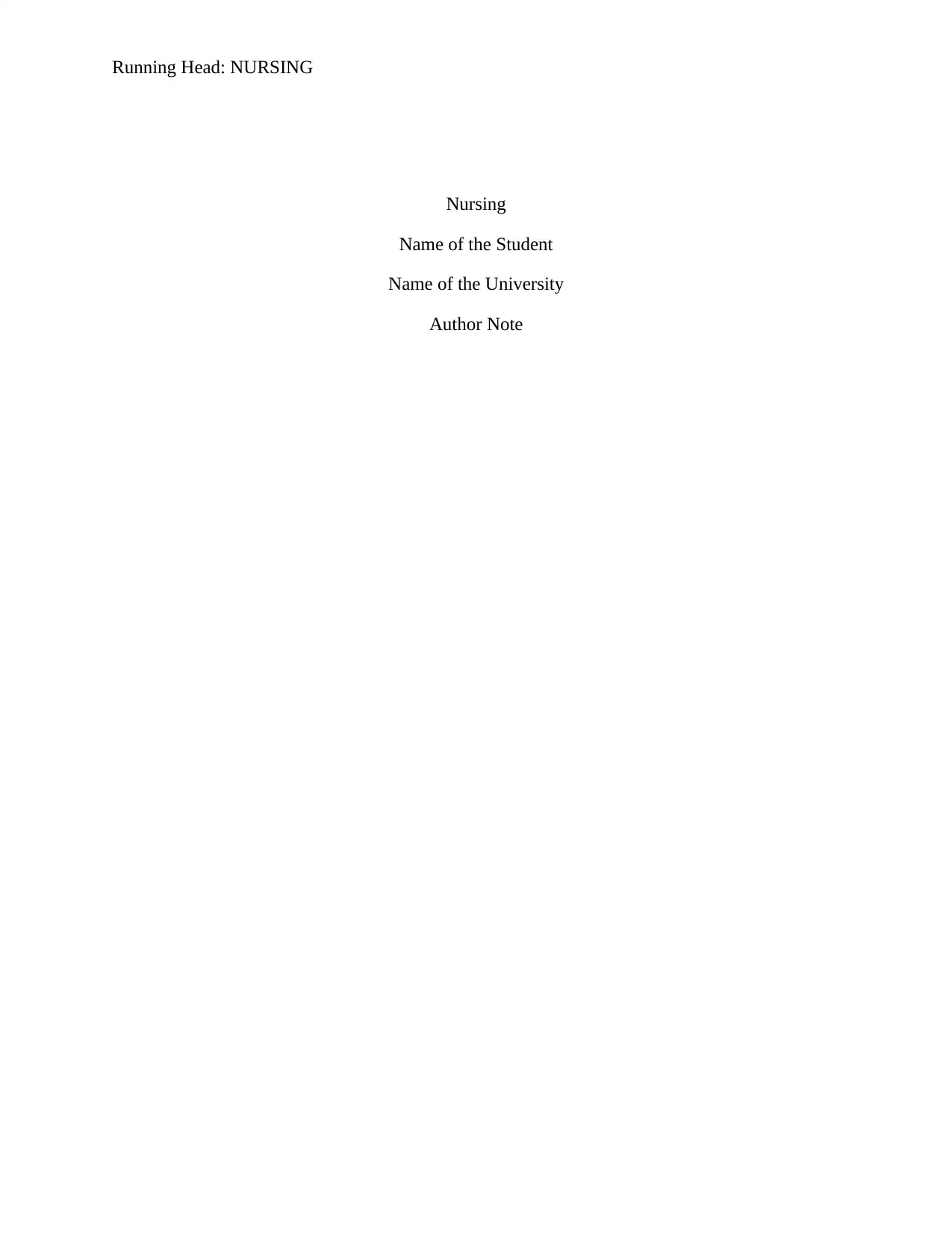
Running Head: NURSING
Nursing
Name of the Student
Name of the University
Author Note
Nursing
Name of the Student
Name of the University
Author Note
Paraphrase This Document
Need a fresh take? Get an instant paraphrase of this document with our AI Paraphraser

2NURSING
The extreme point of stress can lead to individual burnout. In simple words, the burnout
is the emotional disengagement and exhaustion. There are many nurses along with the nursing
students who experience the feeling of the burnout due to the cause of intensity in the work and
the rigor. The nurses usually are found to be dedicating their lives in helping other people. This
can leave impact on the personal along with the professional level. The burnouts can
professionally hinder the performance of the job, change the way nurses view the role and leave
the patients too in danger (Zarei et al., 2016).The burnout destroys the relationships, the
demeanor and the quality of the life. It is considered as one of the most forward dimensions of
the distress which goes beyond the feeling of tiredness and experiences of a bad day while
working. It is further defined to be the mental, the emotional and the physical exhaustion that is
caused by the prolonged and excessive stress.
It leaves impact on the personal lives of the nurses, the patients who are taken care of
along with the organizations that have labeled recently the burnout being one medical diagnosis
(Lee et al., 2016). The nurses in the healthcare organizations face many challenges. Notably,
technology further continues to be changing fast and there is a requirement of the cultural
sensitivity that will expand for sure and the work pressure will keep going while staying,
attentive, sharp and depending on the skills being a part of the profession. In this essay one
professional nursing issue will be selected that is the issue of nursing burnout and then focus on
issue discussing some solutions to the issue as the implementation of the new policies at the
hospitals or at the levels of state governments.
Reasons behind nursing burnout
The extreme point of stress can lead to individual burnout. In simple words, the burnout
is the emotional disengagement and exhaustion. There are many nurses along with the nursing
students who experience the feeling of the burnout due to the cause of intensity in the work and
the rigor. The nurses usually are found to be dedicating their lives in helping other people. This
can leave impact on the personal along with the professional level. The burnouts can
professionally hinder the performance of the job, change the way nurses view the role and leave
the patients too in danger (Zarei et al., 2016).The burnout destroys the relationships, the
demeanor and the quality of the life. It is considered as one of the most forward dimensions of
the distress which goes beyond the feeling of tiredness and experiences of a bad day while
working. It is further defined to be the mental, the emotional and the physical exhaustion that is
caused by the prolonged and excessive stress.
It leaves impact on the personal lives of the nurses, the patients who are taken care of
along with the organizations that have labeled recently the burnout being one medical diagnosis
(Lee et al., 2016). The nurses in the healthcare organizations face many challenges. Notably,
technology further continues to be changing fast and there is a requirement of the cultural
sensitivity that will expand for sure and the work pressure will keep going while staying,
attentive, sharp and depending on the skills being a part of the profession. In this essay one
professional nursing issue will be selected that is the issue of nursing burnout and then focus on
issue discussing some solutions to the issue as the implementation of the new policies at the
hospitals or at the levels of state governments.
Reasons behind nursing burnout

3NURSING
There are many reasons behind the burnouts of the nurses such as the long work hours,
the greater workloads, the poor work environment and others. The stress has been considered to
be one antecedent or the consequence or the response and the interaction. It is further studied that
a psychological assessment which supports the consideration of the connection between illness
and the stress (Nantsupawat et al., 2017). There is a proven relationship between the illness and
the stress. It is advocated by some scholars that stress establishes a specific connection between
the environment and the people who are working.. Also the traits of the personality leave impact
on the equation of stress due to the fact that one person is over tasked which can be exhilarating
to another person. Stress also has been considered to be one occupational hazard from the
beginning of 1950s and occupational stress is one significant health issue also (White, Aiken &
McHugh, 2019). In the field of nursing, the work stress was first identified in the 1960 when the
sources of anxiety of nurses such as decision making, patient care, responsibility taking and
change were identified. The role of the nurse is stress occupied, founded on the human suffering
and physical labour, the interpersonal relationship, the work hours which are core of the
activities of the nurses.
The responsibilities of the workers have been described to be of chronic stress which is
common in the professions consisting of many interactions with many people. Therefore,
Burnout is conceptualized as being one syndrome that is featured by the exhaustion of the
emotional state, the reduced accomplishment of an individual, depersonalization and others.
There are some other reasons for not seeing Burnout, as condition the influence of the leader and
also the demographic traits. As per one report of the World Health Organisation in the year 2006,
the issue of the shortage in Healthcare provider has been pointed out where the shortage of the
nurses is one significant issue which can leave impact on the entire international efforts in terms
There are many reasons behind the burnouts of the nurses such as the long work hours,
the greater workloads, the poor work environment and others. The stress has been considered to
be one antecedent or the consequence or the response and the interaction. It is further studied that
a psychological assessment which supports the consideration of the connection between illness
and the stress (Nantsupawat et al., 2017). There is a proven relationship between the illness and
the stress. It is advocated by some scholars that stress establishes a specific connection between
the environment and the people who are working.. Also the traits of the personality leave impact
on the equation of stress due to the fact that one person is over tasked which can be exhilarating
to another person. Stress also has been considered to be one occupational hazard from the
beginning of 1950s and occupational stress is one significant health issue also (White, Aiken &
McHugh, 2019). In the field of nursing, the work stress was first identified in the 1960 when the
sources of anxiety of nurses such as decision making, patient care, responsibility taking and
change were identified. The role of the nurse is stress occupied, founded on the human suffering
and physical labour, the interpersonal relationship, the work hours which are core of the
activities of the nurses.
The responsibilities of the workers have been described to be of chronic stress which is
common in the professions consisting of many interactions with many people. Therefore,
Burnout is conceptualized as being one syndrome that is featured by the exhaustion of the
emotional state, the reduced accomplishment of an individual, depersonalization and others.
There are some other reasons for not seeing Burnout, as condition the influence of the leader and
also the demographic traits. As per one report of the World Health Organisation in the year 2006,
the issue of the shortage in Healthcare provider has been pointed out where the shortage of the
nurses is one significant issue which can leave impact on the entire international efforts in terms
⊘ This is a preview!⊘
Do you want full access?
Subscribe today to unlock all pages.

Trusted by 1+ million students worldwide
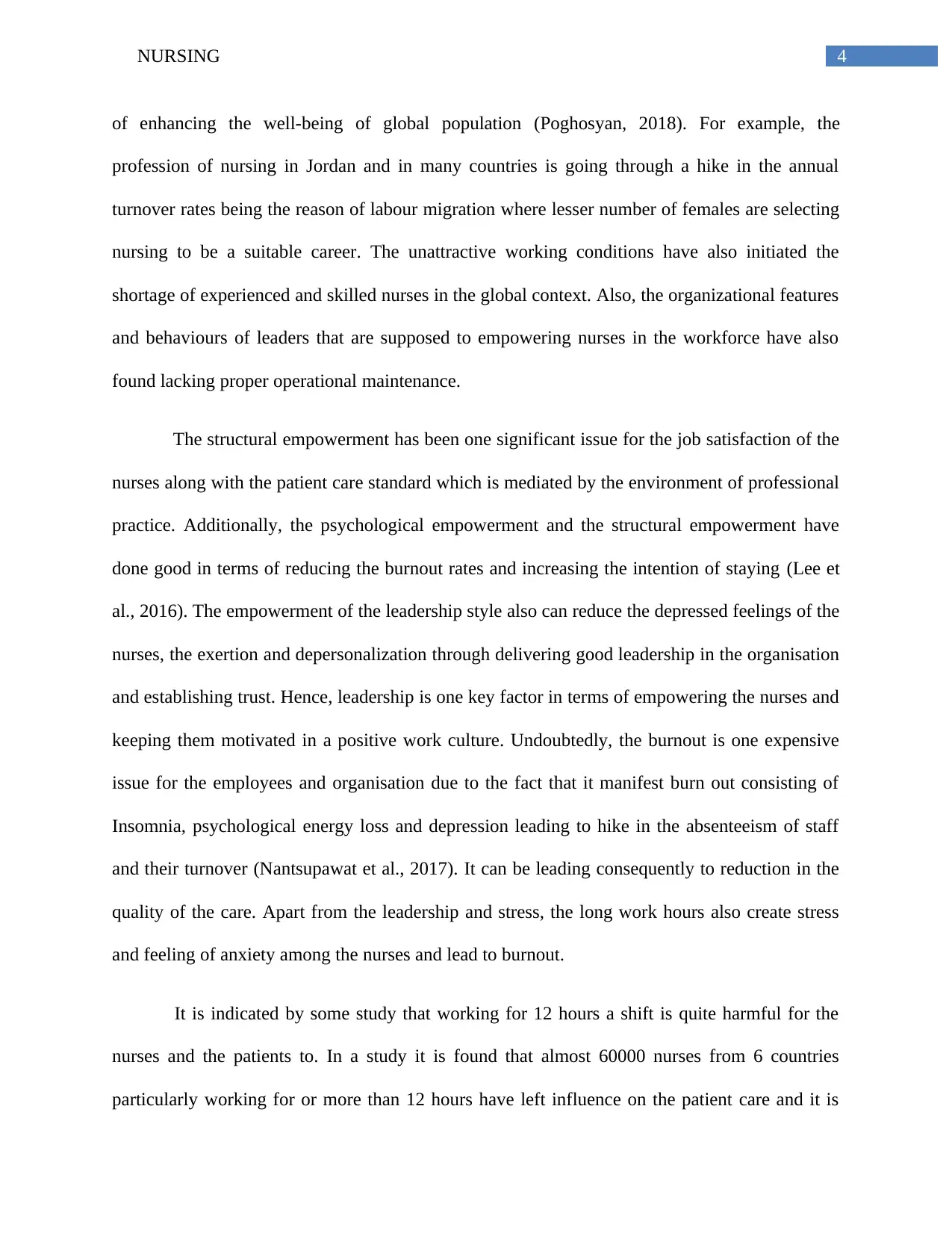
4NURSING
of enhancing the well-being of global population (Poghosyan, 2018). For example, the
profession of nursing in Jordan and in many countries is going through a hike in the annual
turnover rates being the reason of labour migration where lesser number of females are selecting
nursing to be a suitable career. The unattractive working conditions have also initiated the
shortage of experienced and skilled nurses in the global context. Also, the organizational features
and behaviours of leaders that are supposed to empowering nurses in the workforce have also
found lacking proper operational maintenance.
The structural empowerment has been one significant issue for the job satisfaction of the
nurses along with the patient care standard which is mediated by the environment of professional
practice. Additionally, the psychological empowerment and the structural empowerment have
done good in terms of reducing the burnout rates and increasing the intention of staying (Lee et
al., 2016). The empowerment of the leadership style also can reduce the depressed feelings of the
nurses, the exertion and depersonalization through delivering good leadership in the organisation
and establishing trust. Hence, leadership is one key factor in terms of empowering the nurses and
keeping them motivated in a positive work culture. Undoubtedly, the burnout is one expensive
issue for the employees and organisation due to the fact that it manifest burn out consisting of
Insomnia, psychological energy loss and depression leading to hike in the absenteeism of staff
and their turnover (Nantsupawat et al., 2017). It can be leading consequently to reduction in the
quality of the care. Apart from the leadership and stress, the long work hours also create stress
and feeling of anxiety among the nurses and lead to burnout.
It is indicated by some study that working for 12 hours a shift is quite harmful for the
nurses and the patients to. In a study it is found that almost 60000 nurses from 6 countries
particularly working for or more than 12 hours have left influence on the patient care and it is
of enhancing the well-being of global population (Poghosyan, 2018). For example, the
profession of nursing in Jordan and in many countries is going through a hike in the annual
turnover rates being the reason of labour migration where lesser number of females are selecting
nursing to be a suitable career. The unattractive working conditions have also initiated the
shortage of experienced and skilled nurses in the global context. Also, the organizational features
and behaviours of leaders that are supposed to empowering nurses in the workforce have also
found lacking proper operational maintenance.
The structural empowerment has been one significant issue for the job satisfaction of the
nurses along with the patient care standard which is mediated by the environment of professional
practice. Additionally, the psychological empowerment and the structural empowerment have
done good in terms of reducing the burnout rates and increasing the intention of staying (Lee et
al., 2016). The empowerment of the leadership style also can reduce the depressed feelings of the
nurses, the exertion and depersonalization through delivering good leadership in the organisation
and establishing trust. Hence, leadership is one key factor in terms of empowering the nurses and
keeping them motivated in a positive work culture. Undoubtedly, the burnout is one expensive
issue for the employees and organisation due to the fact that it manifest burn out consisting of
Insomnia, psychological energy loss and depression leading to hike in the absenteeism of staff
and their turnover (Nantsupawat et al., 2017). It can be leading consequently to reduction in the
quality of the care. Apart from the leadership and stress, the long work hours also create stress
and feeling of anxiety among the nurses and lead to burnout.
It is indicated by some study that working for 12 hours a shift is quite harmful for the
nurses and the patients to. In a study it is found that almost 60000 nurses from 6 countries
particularly working for or more than 12 hours have left influence on the patient care and it is
Paraphrase This Document
Need a fresh take? Get an instant paraphrase of this document with our AI Paraphraser
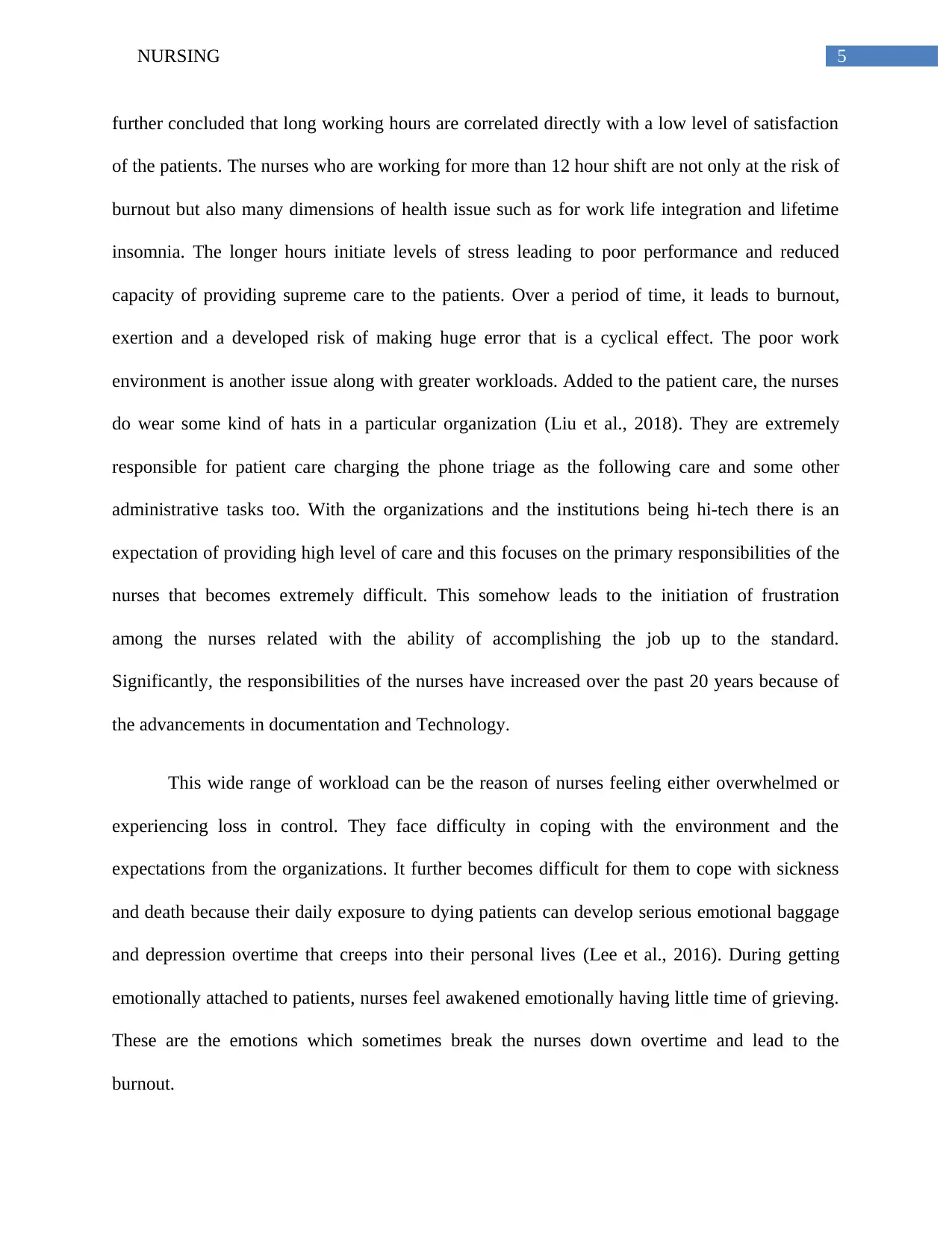
5NURSING
further concluded that long working hours are correlated directly with a low level of satisfaction
of the patients. The nurses who are working for more than 12 hour shift are not only at the risk of
burnout but also many dimensions of health issue such as for work life integration and lifetime
insomnia. The longer hours initiate levels of stress leading to poor performance and reduced
capacity of providing supreme care to the patients. Over a period of time, it leads to burnout,
exertion and a developed risk of making huge error that is a cyclical effect. The poor work
environment is another issue along with greater workloads. Added to the patient care, the nurses
do wear some kind of hats in a particular organization (Liu et al., 2018). They are extremely
responsible for patient care charging the phone triage as the following care and some other
administrative tasks too. With the organizations and the institutions being hi-tech there is an
expectation of providing high level of care and this focuses on the primary responsibilities of the
nurses that becomes extremely difficult. This somehow leads to the initiation of frustration
among the nurses related with the ability of accomplishing the job up to the standard.
Significantly, the responsibilities of the nurses have increased over the past 20 years because of
the advancements in documentation and Technology.
This wide range of workload can be the reason of nurses feeling either overwhelmed or
experiencing loss in control. They face difficulty in coping with the environment and the
expectations from the organizations. It further becomes difficult for them to cope with sickness
and death because their daily exposure to dying patients can develop serious emotional baggage
and depression overtime that creeps into their personal lives (Lee et al., 2016). During getting
emotionally attached to patients, nurses feel awakened emotionally having little time of grieving.
These are the emotions which sometimes break the nurses down overtime and lead to the
burnout.
further concluded that long working hours are correlated directly with a low level of satisfaction
of the patients. The nurses who are working for more than 12 hour shift are not only at the risk of
burnout but also many dimensions of health issue such as for work life integration and lifetime
insomnia. The longer hours initiate levels of stress leading to poor performance and reduced
capacity of providing supreme care to the patients. Over a period of time, it leads to burnout,
exertion and a developed risk of making huge error that is a cyclical effect. The poor work
environment is another issue along with greater workloads. Added to the patient care, the nurses
do wear some kind of hats in a particular organization (Liu et al., 2018). They are extremely
responsible for patient care charging the phone triage as the following care and some other
administrative tasks too. With the organizations and the institutions being hi-tech there is an
expectation of providing high level of care and this focuses on the primary responsibilities of the
nurses that becomes extremely difficult. This somehow leads to the initiation of frustration
among the nurses related with the ability of accomplishing the job up to the standard.
Significantly, the responsibilities of the nurses have increased over the past 20 years because of
the advancements in documentation and Technology.
This wide range of workload can be the reason of nurses feeling either overwhelmed or
experiencing loss in control. They face difficulty in coping with the environment and the
expectations from the organizations. It further becomes difficult for them to cope with sickness
and death because their daily exposure to dying patients can develop serious emotional baggage
and depression overtime that creeps into their personal lives (Lee et al., 2016). During getting
emotionally attached to patients, nurses feel awakened emotionally having little time of grieving.
These are the emotions which sometimes break the nurses down overtime and lead to the
burnout.
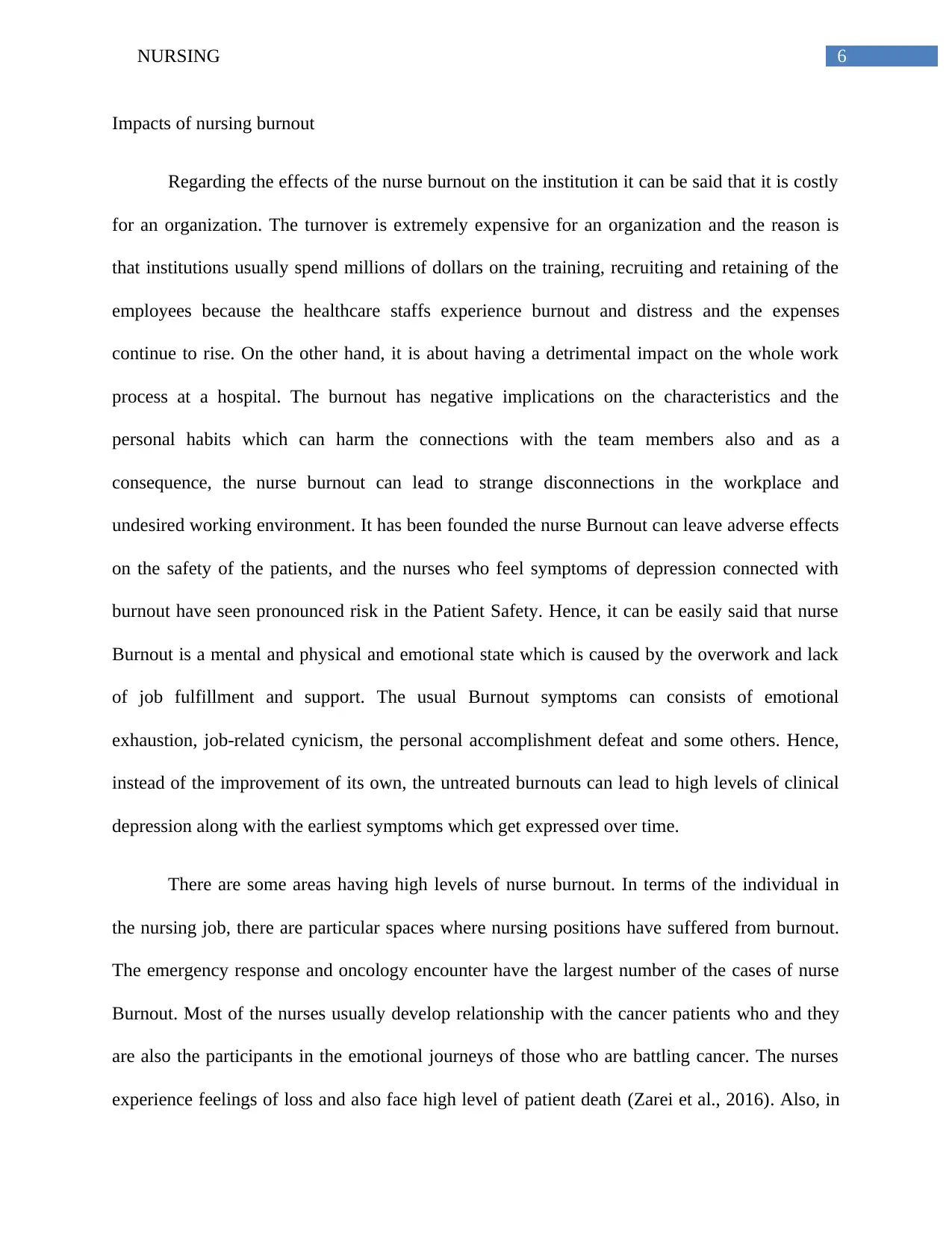
6NURSING
Impacts of nursing burnout
Regarding the effects of the nurse burnout on the institution it can be said that it is costly
for an organization. The turnover is extremely expensive for an organization and the reason is
that institutions usually spend millions of dollars on the training, recruiting and retaining of the
employees because the healthcare staffs experience burnout and distress and the expenses
continue to rise. On the other hand, it is about having a detrimental impact on the whole work
process at a hospital. The burnout has negative implications on the characteristics and the
personal habits which can harm the connections with the team members also and as a
consequence, the nurse burnout can lead to strange disconnections in the workplace and
undesired working environment. It has been founded the nurse Burnout can leave adverse effects
on the safety of the patients, and the nurses who feel symptoms of depression connected with
burnout have seen pronounced risk in the Patient Safety. Hence, it can be easily said that nurse
Burnout is a mental and physical and emotional state which is caused by the overwork and lack
of job fulfillment and support. The usual Burnout symptoms can consists of emotional
exhaustion, job-related cynicism, the personal accomplishment defeat and some others. Hence,
instead of the improvement of its own, the untreated burnouts can lead to high levels of clinical
depression along with the earliest symptoms which get expressed over time.
There are some areas having high levels of nurse burnout. In terms of the individual in
the nursing job, there are particular spaces where nursing positions have suffered from burnout.
The emergency response and oncology encounter have the largest number of the cases of nurse
Burnout. Most of the nurses usually develop relationship with the cancer patients who and they
are also the participants in the emotional journeys of those who are battling cancer. The nurses
experience feelings of loss and also face high level of patient death (Zarei et al., 2016). Also, in
Impacts of nursing burnout
Regarding the effects of the nurse burnout on the institution it can be said that it is costly
for an organization. The turnover is extremely expensive for an organization and the reason is
that institutions usually spend millions of dollars on the training, recruiting and retaining of the
employees because the healthcare staffs experience burnout and distress and the expenses
continue to rise. On the other hand, it is about having a detrimental impact on the whole work
process at a hospital. The burnout has negative implications on the characteristics and the
personal habits which can harm the connections with the team members also and as a
consequence, the nurse burnout can lead to strange disconnections in the workplace and
undesired working environment. It has been founded the nurse Burnout can leave adverse effects
on the safety of the patients, and the nurses who feel symptoms of depression connected with
burnout have seen pronounced risk in the Patient Safety. Hence, it can be easily said that nurse
Burnout is a mental and physical and emotional state which is caused by the overwork and lack
of job fulfillment and support. The usual Burnout symptoms can consists of emotional
exhaustion, job-related cynicism, the personal accomplishment defeat and some others. Hence,
instead of the improvement of its own, the untreated burnouts can lead to high levels of clinical
depression along with the earliest symptoms which get expressed over time.
There are some areas having high levels of nurse burnout. In terms of the individual in
the nursing job, there are particular spaces where nursing positions have suffered from burnout.
The emergency response and oncology encounter have the largest number of the cases of nurse
Burnout. Most of the nurses usually develop relationship with the cancer patients who and they
are also the participants in the emotional journeys of those who are battling cancer. The nurses
experience feelings of loss and also face high level of patient death (Zarei et al., 2016). Also, in
⊘ This is a preview!⊘
Do you want full access?
Subscribe today to unlock all pages.

Trusted by 1+ million students worldwide
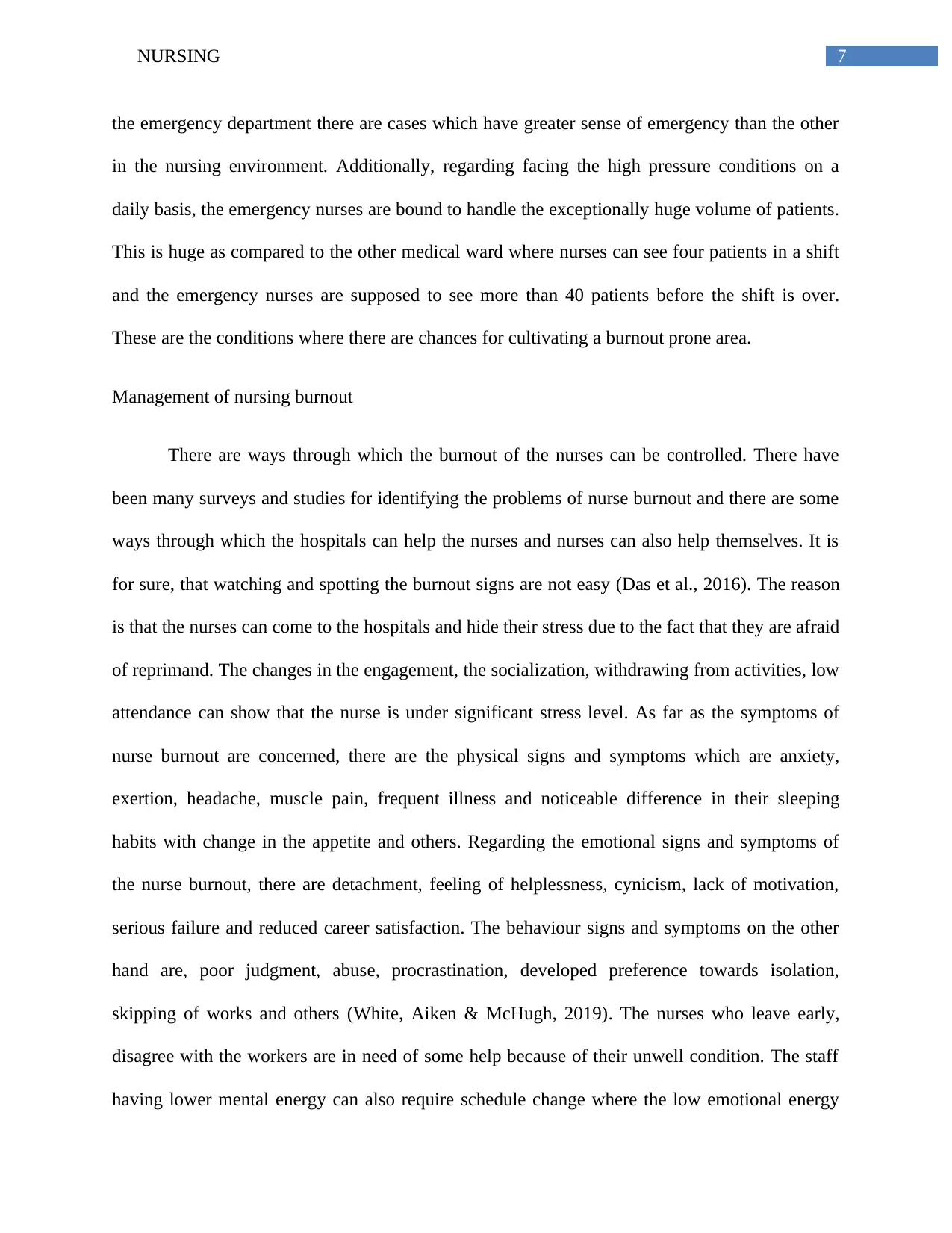
7NURSING
the emergency department there are cases which have greater sense of emergency than the other
in the nursing environment. Additionally, regarding facing the high pressure conditions on a
daily basis, the emergency nurses are bound to handle the exceptionally huge volume of patients.
This is huge as compared to the other medical ward where nurses can see four patients in a shift
and the emergency nurses are supposed to see more than 40 patients before the shift is over.
These are the conditions where there are chances for cultivating a burnout prone area.
Management of nursing burnout
There are ways through which the burnout of the nurses can be controlled. There have
been many surveys and studies for identifying the problems of nurse burnout and there are some
ways through which the hospitals can help the nurses and nurses can also help themselves. It is
for sure, that watching and spotting the burnout signs are not easy (Das et al., 2016). The reason
is that the nurses can come to the hospitals and hide their stress due to the fact that they are afraid
of reprimand. The changes in the engagement, the socialization, withdrawing from activities, low
attendance can show that the nurse is under significant stress level. As far as the symptoms of
nurse burnout are concerned, there are the physical signs and symptoms which are anxiety,
exertion, headache, muscle pain, frequent illness and noticeable difference in their sleeping
habits with change in the appetite and others. Regarding the emotional signs and symptoms of
the nurse burnout, there are detachment, feeling of helplessness, cynicism, lack of motivation,
serious failure and reduced career satisfaction. The behaviour signs and symptoms on the other
hand are, poor judgment, abuse, procrastination, developed preference towards isolation,
skipping of works and others (White, Aiken & McHugh, 2019). The nurses who leave early,
disagree with the workers are in need of some help because of their unwell condition. The staff
having lower mental energy can also require schedule change where the low emotional energy
the emergency department there are cases which have greater sense of emergency than the other
in the nursing environment. Additionally, regarding facing the high pressure conditions on a
daily basis, the emergency nurses are bound to handle the exceptionally huge volume of patients.
This is huge as compared to the other medical ward where nurses can see four patients in a shift
and the emergency nurses are supposed to see more than 40 patients before the shift is over.
These are the conditions where there are chances for cultivating a burnout prone area.
Management of nursing burnout
There are ways through which the burnout of the nurses can be controlled. There have
been many surveys and studies for identifying the problems of nurse burnout and there are some
ways through which the hospitals can help the nurses and nurses can also help themselves. It is
for sure, that watching and spotting the burnout signs are not easy (Das et al., 2016). The reason
is that the nurses can come to the hospitals and hide their stress due to the fact that they are afraid
of reprimand. The changes in the engagement, the socialization, withdrawing from activities, low
attendance can show that the nurse is under significant stress level. As far as the symptoms of
nurse burnout are concerned, there are the physical signs and symptoms which are anxiety,
exertion, headache, muscle pain, frequent illness and noticeable difference in their sleeping
habits with change in the appetite and others. Regarding the emotional signs and symptoms of
the nurse burnout, there are detachment, feeling of helplessness, cynicism, lack of motivation,
serious failure and reduced career satisfaction. The behaviour signs and symptoms on the other
hand are, poor judgment, abuse, procrastination, developed preference towards isolation,
skipping of works and others (White, Aiken & McHugh, 2019). The nurses who leave early,
disagree with the workers are in need of some help because of their unwell condition. The staff
having lower mental energy can also require schedule change where the low emotional energy
Paraphrase This Document
Need a fresh take? Get an instant paraphrase of this document with our AI Paraphraser

8NURSING
can be crucial in the interpersonal environment (Doulougeri, Georganta & Montgomery, 2016).
Therefore, the annual surveys are not enough and the employees should be examined every day
based on their energy. This type of energy assessment tool can be of great help for measuring the
human energy crisis of the organization. The nurses can be taught about the self-care strategies.
Engagement of the workers is also useful in terms of development. The wellness should always
be made a priority and the nurses should be given break time because lack of break time can lead
to higher levels of stress. The hospitals only can make sure that the nurses are taking sufficient
time off when they on duty so that a work-life balance is maintained.
Policies for reducing Nurse Burnout
As far as the policies are concerned the duty of care for the nurses should be implemented
in all healthcare organizations. The duty of care suggests that the nurses should have a duty of
care for the patients as well as for themselves. This is related to the instruction which is in flight
offered at the beginning of the flight. It is about checking if the passengers have put on the belts
by themselves before assisting the other passengers. In a similar way the nurses cannot care for
the patients properly if they are under unhealthy circumstances. The burn out of the nurses leaves
impact on the patient care and the Health Organizations through many ways. Firstly, the stressed
out and exhausted nurses are likely to make wrong decisions at the work. The reason is that
stress can leave impact on the decision making ability of an individual and the nurse burnout is
connected with the rates of infections acquired in the hospital. It is found that almost 50% of the
registered nurses who are under the age of 30 have experienced burnout.
The stressed population of the nurses leaves disengagement of the patients (Havens,
Gittell & Vasey, 2018) towards the patient The healthcare burnout cannot concentrate on the
can be crucial in the interpersonal environment (Doulougeri, Georganta & Montgomery, 2016).
Therefore, the annual surveys are not enough and the employees should be examined every day
based on their energy. This type of energy assessment tool can be of great help for measuring the
human energy crisis of the organization. The nurses can be taught about the self-care strategies.
Engagement of the workers is also useful in terms of development. The wellness should always
be made a priority and the nurses should be given break time because lack of break time can lead
to higher levels of stress. The hospitals only can make sure that the nurses are taking sufficient
time off when they on duty so that a work-life balance is maintained.
Policies for reducing Nurse Burnout
As far as the policies are concerned the duty of care for the nurses should be implemented
in all healthcare organizations. The duty of care suggests that the nurses should have a duty of
care for the patients as well as for themselves. This is related to the instruction which is in flight
offered at the beginning of the flight. It is about checking if the passengers have put on the belts
by themselves before assisting the other passengers. In a similar way the nurses cannot care for
the patients properly if they are under unhealthy circumstances. The burn out of the nurses leaves
impact on the patient care and the Health Organizations through many ways. Firstly, the stressed
out and exhausted nurses are likely to make wrong decisions at the work. The reason is that
stress can leave impact on the decision making ability of an individual and the nurse burnout is
connected with the rates of infections acquired in the hospital. It is found that almost 50% of the
registered nurses who are under the age of 30 have experienced burnout.
The stressed population of the nurses leaves disengagement of the patients (Havens,
Gittell & Vasey, 2018) towards the patient The healthcare burnout cannot concentrate on the

9NURSING
nurses themselves and the reason is that the nurses base their personal responsibilities for caring
for themselves and the organization. The organization should empower the nurses for advocating
for the patients along with themselves. The policymakers should reframe the rules in such a way
which values and then promotes the interaction of people that is the core of all types of healing
(Nursesonboardscoalition.org, 2020). The policymakers should streamline the documentation.
The electronic medical record has been found to be a roadblock to the patient care and reason for
the development of stress for the caregivers. These are the common feelings among the nurses
displayed when they suffer from terrible burnout.
They appear rude with the patients who do not offer much guidance or become helpful to
them as they used to be in the past years. Also the medical professionals suffering from extreme
depersonalization are likely to have an experience of poor connection with patients which could
leave impact on the experience of a patient in the medical facility and also prevent people from
having trust over the medical authority and the treatment in the future. The physician and the
nurse usually blame the EMR, the EHR system that interfere with the connections with patients
and takes time from the patients. Also, the policymakers should standardize the metrics in terms
of measuring the burnout and tie the financial incentives with the improvement. There are some
metrics that help in measuring the job satisfaction and the employee engagement. However,
these points are not been intensely pursued for measuring the patient experiences. Healthcare
organizations should take up these metrics in a serious note and work for improving the points
and the nursing satisfaction should definitely be valued at a high level. There should further be a
system forwarding the middle manager for supporting the employees.
The policies of the organizations might call for the nurses to have the brakes but leaders
may select to reject the nurse breaks and the lunch due to the patient demand. There are shortage
nurses themselves and the reason is that the nurses base their personal responsibilities for caring
for themselves and the organization. The organization should empower the nurses for advocating
for the patients along with themselves. The policymakers should reframe the rules in such a way
which values and then promotes the interaction of people that is the core of all types of healing
(Nursesonboardscoalition.org, 2020). The policymakers should streamline the documentation.
The electronic medical record has been found to be a roadblock to the patient care and reason for
the development of stress for the caregivers. These are the common feelings among the nurses
displayed when they suffer from terrible burnout.
They appear rude with the patients who do not offer much guidance or become helpful to
them as they used to be in the past years. Also the medical professionals suffering from extreme
depersonalization are likely to have an experience of poor connection with patients which could
leave impact on the experience of a patient in the medical facility and also prevent people from
having trust over the medical authority and the treatment in the future. The physician and the
nurse usually blame the EMR, the EHR system that interfere with the connections with patients
and takes time from the patients. Also, the policymakers should standardize the metrics in terms
of measuring the burnout and tie the financial incentives with the improvement. There are some
metrics that help in measuring the job satisfaction and the employee engagement. However,
these points are not been intensely pursued for measuring the patient experiences. Healthcare
organizations should take up these metrics in a serious note and work for improving the points
and the nursing satisfaction should definitely be valued at a high level. There should further be a
system forwarding the middle manager for supporting the employees.
The policies of the organizations might call for the nurses to have the brakes but leaders
may select to reject the nurse breaks and the lunch due to the patient demand. There are shortage
⊘ This is a preview!⊘
Do you want full access?
Subscribe today to unlock all pages.

Trusted by 1+ million students worldwide
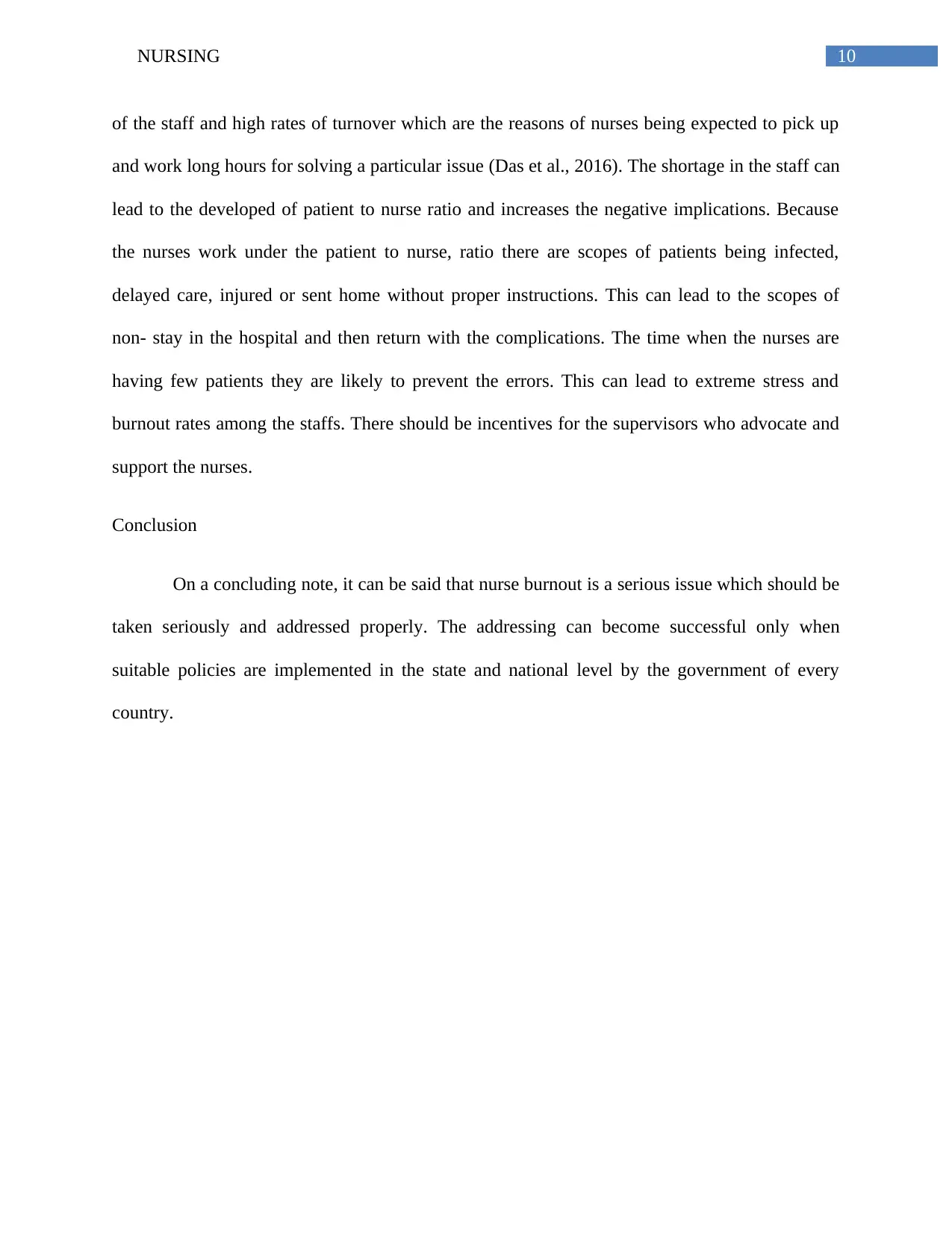
10NURSING
of the staff and high rates of turnover which are the reasons of nurses being expected to pick up
and work long hours for solving a particular issue (Das et al., 2016). The shortage in the staff can
lead to the developed of patient to nurse ratio and increases the negative implications. Because
the nurses work under the patient to nurse, ratio there are scopes of patients being infected,
delayed care, injured or sent home without proper instructions. This can lead to the scopes of
non- stay in the hospital and then return with the complications. The time when the nurses are
having few patients they are likely to prevent the errors. This can lead to extreme stress and
burnout rates among the staffs. There should be incentives for the supervisors who advocate and
support the nurses.
Conclusion
On a concluding note, it can be said that nurse burnout is a serious issue which should be
taken seriously and addressed properly. The addressing can become successful only when
suitable policies are implemented in the state and national level by the government of every
country.
of the staff and high rates of turnover which are the reasons of nurses being expected to pick up
and work long hours for solving a particular issue (Das et al., 2016). The shortage in the staff can
lead to the developed of patient to nurse ratio and increases the negative implications. Because
the nurses work under the patient to nurse, ratio there are scopes of patients being infected,
delayed care, injured or sent home without proper instructions. This can lead to the scopes of
non- stay in the hospital and then return with the complications. The time when the nurses are
having few patients they are likely to prevent the errors. This can lead to extreme stress and
burnout rates among the staffs. There should be incentives for the supervisors who advocate and
support the nurses.
Conclusion
On a concluding note, it can be said that nurse burnout is a serious issue which should be
taken seriously and addressed properly. The addressing can become successful only when
suitable policies are implemented in the state and national level by the government of every
country.
Paraphrase This Document
Need a fresh take? Get an instant paraphrase of this document with our AI Paraphraser
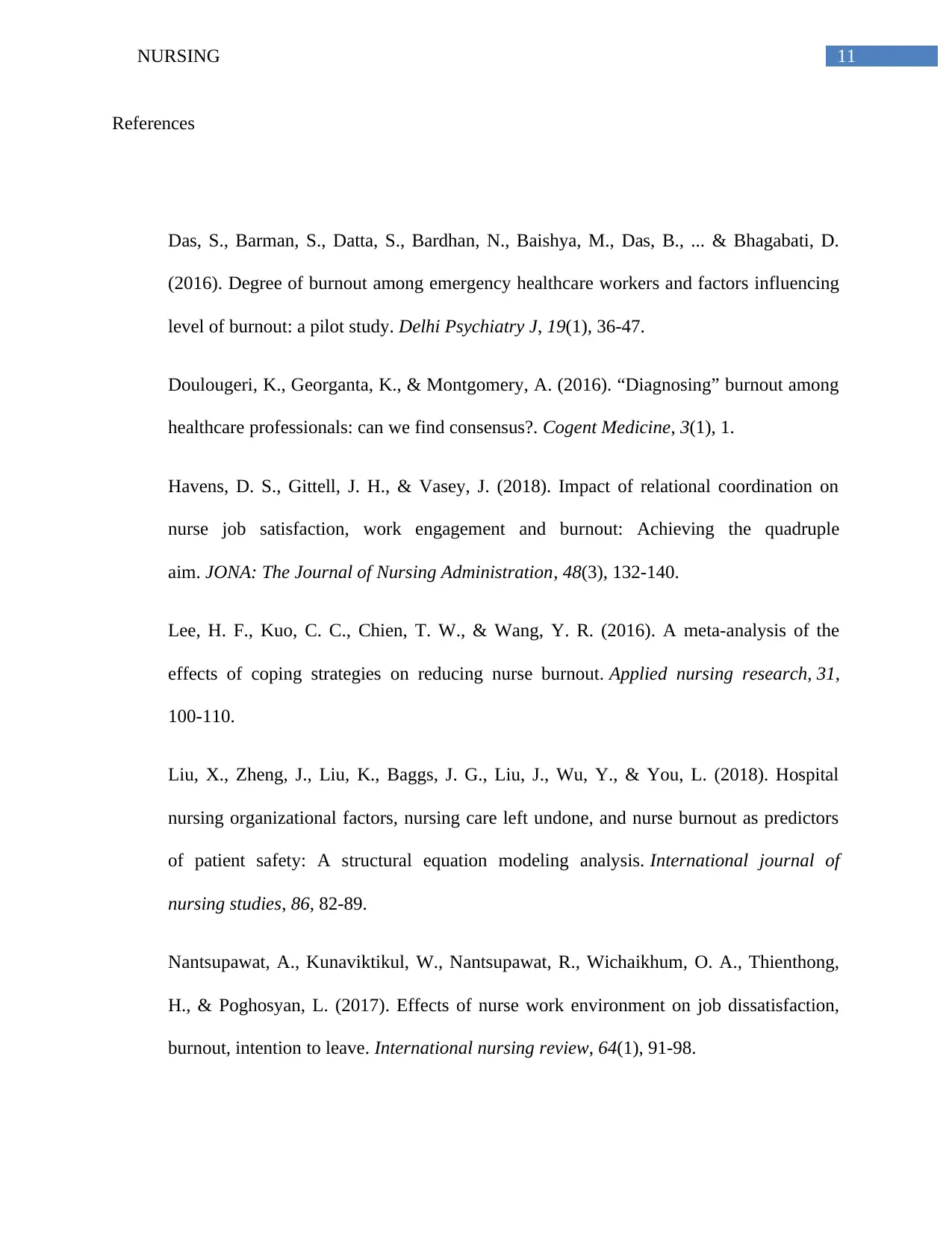
11NURSING
References
Das, S., Barman, S., Datta, S., Bardhan, N., Baishya, M., Das, B., ... & Bhagabati, D.
(2016). Degree of burnout among emergency healthcare workers and factors influencing
level of burnout: a pilot study. Delhi Psychiatry J, 19(1), 36-47.
Doulougeri, K., Georganta, K., & Montgomery, A. (2016). “Diagnosing” burnout among
healthcare professionals: can we find consensus?. Cogent Medicine, 3(1), 1.
Havens, D. S., Gittell, J. H., & Vasey, J. (2018). Impact of relational coordination on
nurse job satisfaction, work engagement and burnout: Achieving the quadruple
aim. JONA: The Journal of Nursing Administration, 48(3), 132-140.
Lee, H. F., Kuo, C. C., Chien, T. W., & Wang, Y. R. (2016). A meta-analysis of the
effects of coping strategies on reducing nurse burnout. Applied nursing research, 31,
100-110.
Liu, X., Zheng, J., Liu, K., Baggs, J. G., Liu, J., Wu, Y., & You, L. (2018). Hospital
nursing organizational factors, nursing care left undone, and nurse burnout as predictors
of patient safety: A structural equation modeling analysis. International journal of
nursing studies, 86, 82-89.
Nantsupawat, A., Kunaviktikul, W., Nantsupawat, R., Wichaikhum, O. A., Thienthong,
H., & Poghosyan, L. (2017). Effects of nurse work environment on job dissatisfaction,
burnout, intention to leave. International nursing review, 64(1), 91-98.
References
Das, S., Barman, S., Datta, S., Bardhan, N., Baishya, M., Das, B., ... & Bhagabati, D.
(2016). Degree of burnout among emergency healthcare workers and factors influencing
level of burnout: a pilot study. Delhi Psychiatry J, 19(1), 36-47.
Doulougeri, K., Georganta, K., & Montgomery, A. (2016). “Diagnosing” burnout among
healthcare professionals: can we find consensus?. Cogent Medicine, 3(1), 1.
Havens, D. S., Gittell, J. H., & Vasey, J. (2018). Impact of relational coordination on
nurse job satisfaction, work engagement and burnout: Achieving the quadruple
aim. JONA: The Journal of Nursing Administration, 48(3), 132-140.
Lee, H. F., Kuo, C. C., Chien, T. W., & Wang, Y. R. (2016). A meta-analysis of the
effects of coping strategies on reducing nurse burnout. Applied nursing research, 31,
100-110.
Liu, X., Zheng, J., Liu, K., Baggs, J. G., Liu, J., Wu, Y., & You, L. (2018). Hospital
nursing organizational factors, nursing care left undone, and nurse burnout as predictors
of patient safety: A structural equation modeling analysis. International journal of
nursing studies, 86, 82-89.
Nantsupawat, A., Kunaviktikul, W., Nantsupawat, R., Wichaikhum, O. A., Thienthong,
H., & Poghosyan, L. (2017). Effects of nurse work environment on job dissatisfaction,
burnout, intention to leave. International nursing review, 64(1), 91-98.
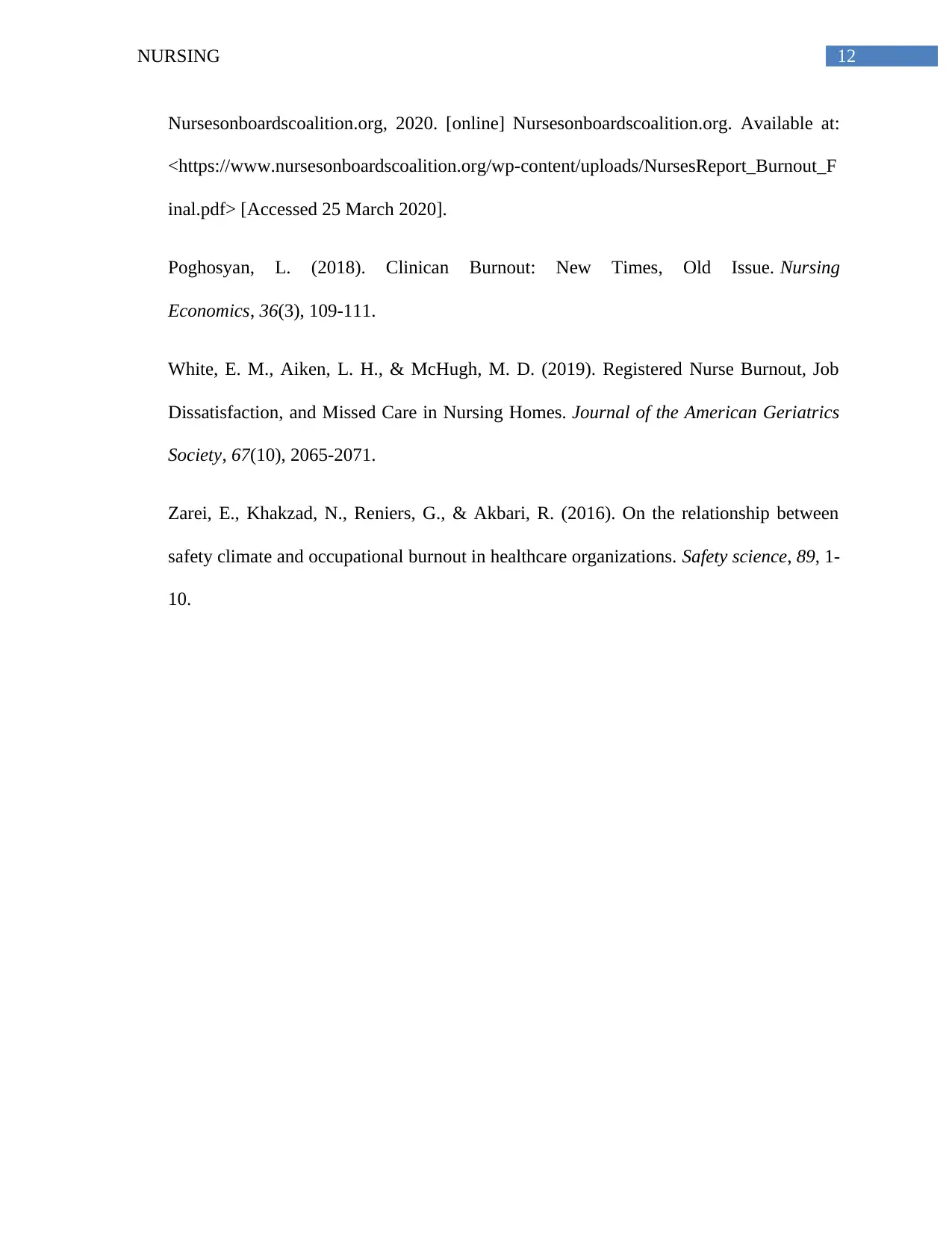
12NURSING
Nursesonboardscoalition.org, 2020. [online] Nursesonboardscoalition.org. Available at:
<https://www.nursesonboardscoalition.org/wp-content/uploads/NursesReport_Burnout_F
inal.pdf> [Accessed 25 March 2020].
Poghosyan, L. (2018). Clinican Burnout: New Times, Old Issue. Nursing
Economics, 36(3), 109-111.
White, E. M., Aiken, L. H., & McHugh, M. D. (2019). Registered Nurse Burnout, Job
Dissatisfaction, and Missed Care in Nursing Homes. Journal of the American Geriatrics
Society, 67(10), 2065-2071.
Zarei, E., Khakzad, N., Reniers, G., & Akbari, R. (2016). On the relationship between
safety climate and occupational burnout in healthcare organizations. Safety science, 89, 1-
10.
Nursesonboardscoalition.org, 2020. [online] Nursesonboardscoalition.org. Available at:
<https://www.nursesonboardscoalition.org/wp-content/uploads/NursesReport_Burnout_F
inal.pdf> [Accessed 25 March 2020].
Poghosyan, L. (2018). Clinican Burnout: New Times, Old Issue. Nursing
Economics, 36(3), 109-111.
White, E. M., Aiken, L. H., & McHugh, M. D. (2019). Registered Nurse Burnout, Job
Dissatisfaction, and Missed Care in Nursing Homes. Journal of the American Geriatrics
Society, 67(10), 2065-2071.
Zarei, E., Khakzad, N., Reniers, G., & Akbari, R. (2016). On the relationship between
safety climate and occupational burnout in healthcare organizations. Safety science, 89, 1-
10.
⊘ This is a preview!⊘
Do you want full access?
Subscribe today to unlock all pages.

Trusted by 1+ million students worldwide
1 out of 12
Related Documents
Your All-in-One AI-Powered Toolkit for Academic Success.
+13062052269
info@desklib.com
Available 24*7 on WhatsApp / Email
![[object Object]](/_next/static/media/star-bottom.7253800d.svg)
Unlock your academic potential
Copyright © 2020–2025 A2Z Services. All Rights Reserved. Developed and managed by ZUCOL.





